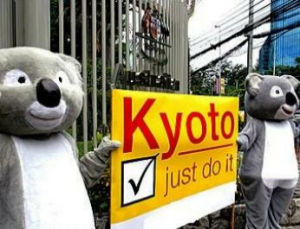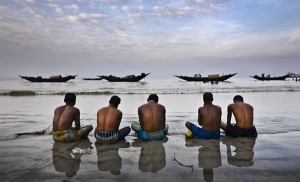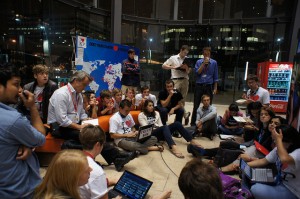On Friday, Australian Climate Change Minister, Greg Combet announced that Australia intends to sign-up to ‘Kyoto2’ and remain part of a…
On Friday, Australian Climate Change Minister, Greg Combet announced that Australia intends to sign-up to ‘Kyoto2’ and remain part of a global climate solution. Great news…After almost of year of campaigning by supporters from organisations like Oxfam, WWF and the Australian Conservation Foundation, the Government finally announced its intentions to be part of the world’s only legally binding agreement to tackle climate change.
Sadly, the New Zealand Government which officially pulled out of Kyoto over the weekend seems to be stuck in Middle Earth - seemingly living in a hole in the ground when it comes to action on climate. By Australia signing onto the second commitment period of the Kyoto Protocol and New Zealand choosing not to, the land of Oz has once again out shined our Kiwi neighbours.
The continuation of Kyoto whilst not the silver bullet solution to tackling climate change does provide the necessary legal and political bridge to the fair, ambitious and binding agreement that all countries have agreed to finalise, hopefully, by 2015.
Whilst, I’m pleased to see the Government reaffirm its commitment to increase its emissions reductions target to 25 per cent by 2020 (on 2000 levels) in the context of a global deal. Australia’s current target is 5 per cent by 2020. Australia as one of the highest per-person emitters will need to prepare itself for deeper cuts in the near future. Significantly, Australia’s independent Climate Change Authority will review and make recommendations on Australia’s emissions reduction targets in early 2014. Current targets, including Australia’s, fall a long way short of what is needed to limit warming to 2C – the threshold for a safe climate. Mid-term ambition will be issue at COP18 and in the negotiations around the Durban Platform for enhanced action. To date, indications are the ambition train is still waiting at the platform looking for someone to drive it at the UNFCCC.
 I’m also worried at the deep uncertainty surrounding sources of climate finance for developing countries at COP18. In 2009, developed countries committed to raising US $100bn a year by 2020 to assist the developing world in adapting to climate change and implementing low carbon development strategies. Australia has played a strong role over the first three years, known as the Fast Start Finance period, providing a fair share towards the global goal of US $30bn between 2010 and 2012. But like most developed countries, it has made no firm, quantified commitments beyond the Fast Start period.
I’m also worried at the deep uncertainty surrounding sources of climate finance for developing countries at COP18. In 2009, developed countries committed to raising US $100bn a year by 2020 to assist the developing world in adapting to climate change and implementing low carbon development strategies. Australia has played a strong role over the first three years, known as the Fast Start Finance period, providing a fair share towards the global goal of US $30bn between 2010 and 2012. But like most developed countries, it has made no firm, quantified commitments beyond the Fast Start period.
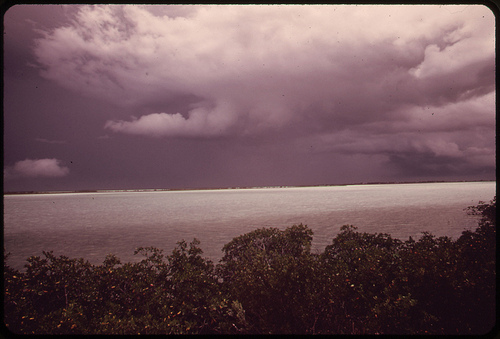
Less than clear skies. Creative Commons
So whilst my government outshone New Zealand last week, the skies looking towards Doha are far from clear…
On Friday, Australian Climate Change Minister, Greg Combet announced that Australia intends to sign-up to ‘Kyoto2’ and remain part of a…
Read post →Australia’s stance on a second commitment of the Kyoto protocol looks set to define Australia’s international standing at the UNFCCC. Will Australia consider withdrawing from Kyoto and derail momentum for international co-operation on climate change?
In 2007, newly elected Prime Minister, Kevin Rudd rode a wave of enthusiasm for climate action all the way to the beaches of Bali and the UN Climate Summit. In Bali, Rudd was a knight in shining armour, signing Australia up to the Kyoto Protocol. With a stroke of the pen, Australia went from climate villain to climate hero. After more than a decade of climate in-action, Australia joined other rich countries, with the exception of the US, in taking on mandatory targets to reduce greenhouse gas emissions.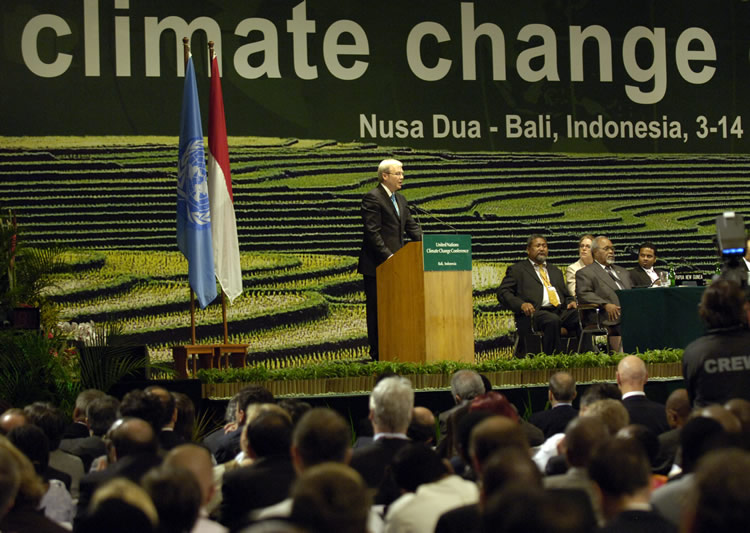
Last year, the Gillard Government against fierce opposition took a positive step forward in legislating for a price on carbon and a $10 billion investment in clean energy. However, at the UN climate talks in Durban, Australia stood still or went backwards on many issues. Other big polluting countries, like the US and Canada, also dragged their heels like around the corridors of the United Nations. Despite this, agreement was reached for a new global deal covering all countries to start in 2020 and for a second commitment period of the Kyoto Protocol. Kyoto is the bedrock of international cooperation on climate change.
At the first round of UN climate talks for 2012, pressure is mounting for Australia to not withdraw from Kyoto. European nations, small island states and least developed countries, often the most vulnerable to changing weather patterns, see the continuation of Kyoto as vital in efforts to reduce emissions. China and India also see Kyoto as important piece of the puzzle if they are to take on legally binding commitments by 2020. Australia exiting from Kyoto would in-turn slow momentum for a new global agreement. The decision could also impact the Government’s attempt for a seat of the UN Security Council.
 Signing on to Kyoto also requires Australia to submit a target to reduce greenhouse gases. There is a risk that Australia could lock in a low target. However, our current 5% target by 2020 on 2000 levels is already well below what is required by science to limit warming to the below 2 degrees. The IPCC recommends rich countries reduce emissions by 25% - 40% by 2020 on 1990 levels. The government’s own policy outlines measures needed to go to the higher end of the 5% – 15% range and a possibility to move to 25%. Significantly, Freedom of Information papers obtained by The Climate Institute show that the conditions for moving to 15% have already been met. Signing on to Kyoto provides Australia with an opportunity to commit to stronger targets.
Signing on to Kyoto also requires Australia to submit a target to reduce greenhouse gases. There is a risk that Australia could lock in a low target. However, our current 5% target by 2020 on 2000 levels is already well below what is required by science to limit warming to the below 2 degrees. The IPCC recommends rich countries reduce emissions by 25% - 40% by 2020 on 1990 levels. The government’s own policy outlines measures needed to go to the higher end of the 5% – 15% range and a possibility to move to 25%. Significantly, Freedom of Information papers obtained by The Climate Institute show that the conditions for moving to 15% have already been met. Signing on to Kyoto provides Australia with an opportunity to commit to stronger targets.
Once again, the Kyoto question looks set to define Australia’s international standing on climate change
Australia’s stance on a second commitment of the Kyoto protocol looks set to define Australia’s international standing at the UNFCCC. Will Australia consider withdrawing from Kyoto and derail momentum for international co-operation on climate change?
Read post →Australia has a new head of delegation. A new negotiator bring new opportunities and new relationships. How will Australia’s new Climate Ambassador shape Australia’s role this year?
After two years at the helm of Australia’s delegation, Louise Hand who also spoke on behalf of the powerful Umbrella group has taken up a gig as the Ambassador of Canada. Needless to say, taking tough on climate change will not be on her agenda in discussions with the Canadian government. Despite the obvious need for it…
Australia’s new Ambassador for Climate Change and lead negotiator at the UNFCCC, Dr Justin Lee was previously Australia’s High Commissioner for Bangladesh. With firsthand experience of working in a country, which is extremely vulnerable to climate change, Dr Lee will know the issues confronting the most vulnerable countries.
Photo: Rodney Dekker/OxfamAUS
With Australia needing to roll up its sleeves and join the coalition of the willing (EU, AOSIS and LDCs) in discussions around legal form and increasing mitigation, I hope that Dr Lee’s experiences of working in Bangladesh might help shape Australia’s position. At COP18 in Durban last year, Australia dragged it heals on many issues (the Green Climate Fund being one exception) joining long-time climate laggard US and Canada in blocking tangible progress.
During the past two weeks of negotiations, other countries have been consistently urging Australia to join up to Kyoto. In particular, small Island states in the Pacific and the least developed countries in Africa and Asia are waiting to see if Australia will stand by them and play its role in international climate action.
The time has come for Australia to get with the program and join with others in a second commitment period of the Kyoto Protocol with strong greenhouse gas reduction goals.
With a new Ambassador, new relationships will need to be formed, with new relationships, new opportunities will arise.
Australia has a new head of delegation. A new negotiator bring new opportunities and new relationships. How will Australia’s new Climate Ambassador shape Australia’s role this year?
Read post →The final countdown. A deal is in sight though will it be any good?
It’s 3am in the morning in Durban. We’ve gone 1 day and bit overtime.
And there’s a faint hint in the air that there might be a historic deal. An agreement on a 2nd commitment period and an agreement to negotiate a legally binding agreement starting in 2018.
The EU and India have just huddled work to see if they can come to a compromise over equity and CBDR.
If a deal does get done, it will be good PR for the multilateral process. However, big questions will remain over the ambition of countries to reduce emissions and keep warming to below 2 degrees.
Also, the Green Climate Fund whilst agreed to, will seemingly be an empty shell.
Time will tell…
The final countdown. A deal is in sight though will it be any good?
Read post →After being kicked out late last night, negotiations have started again and Australia and others need to join the coalition of the willing and support the EU, AOSIS and LDCs…
“We’re back!”
These famous words by the US negotiator a few years ago, shortly after the election of Obama, had a less than positive tone for me this morning walking into the International Conference Centre, venue of this year’s UN Climate Summit.
After four intercessionals (negotiating sessions between the UN climate summits) and eleven long days of negotiations here in Durban the global community still does not have a consensus. So we’re back, hopefully, for only one more day.
These meetings normally finish late on the last day and thus I came prepared last night with a toothbrush, fresh fruit and plenty of water. However, the UNFCCC advised people at around 12:30am last night that negotiations would resume in the morning. Despite this, negotiations kept going until 3am.
So why are we still here?
The Indaba (ministerial meeting for broad political issues) resumed around 6pm last night with small island states and LDCs saying the package was a “death sentence”. The US supported by Australia indicated support for a “legal instrument” instead of “legal framework”. The EU stated that they could not accept this legal outcome. And so the South African presidency returned with a more ambitious text for discussions that went until around 3am last night.
This morning there has been draft text around the LCA and Kyoto Protocol. The LCA text is very weak on the mitigation side, and a cop-out on shared vision, but it does foreshadow a work program on identifying long-term sources of finance. The inclusion of a plan around long-term sources is a flicker of light in otherwise dark hole.
The Kyoto Protocol text calls for a 5-year continuation period but does not have a provision in the amendments for countries to adjust the emission reductions targets after they are supposed to table them in May next year.
So far Australia’s actions have been less than satisfactory. They were one of the only countries to openly support and very very bad deal being botched together by the US and China. They tried very hard to spin it positively to NGOs.
Australia now needs to cross the fence and join the coalition of the willing. This coalition includes the EU, AOSIS and the LDCs who have a clear proposal to establish a plan for increasing ambition to keep the window open for the world to reach the below 2 degree target. The US and others are proposing to slam this window shut, which would have a devastating impact for the world’s poor…
I’m also blogging on our sister site, A Climate for Change (www.aclimateforchange.org). Read more of my work there….
After being kicked out late last night, negotiations have started again and Australia and others need to join the coalition of the willing and support the EU, AOSIS and LDCs…
Read post →About the author
Clancy MooreClancy Moore is Australia's UN Climate Tracker for 2011. He currently works for Oxfam as a Campaigner, lecturers in sustainability and is a facilitator of social change. He has also worked on advocacy projects in the Solomon Islands and North East Brazil. You can read more of Clancy's work at A Climate for Change.
- Tweets by





